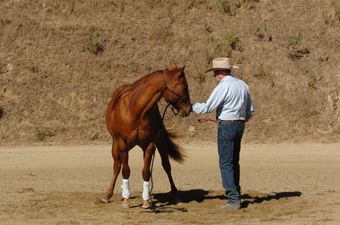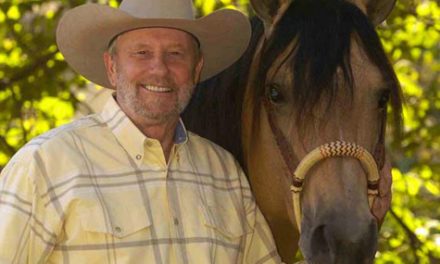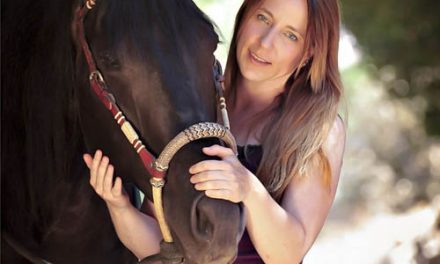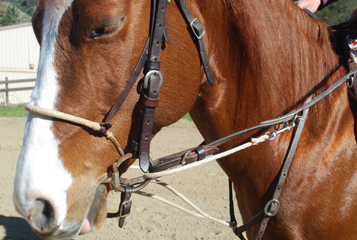
Left concentrated circle with good bending
In the training program at the ranch we never, ever ride a horse without first starting with a bit of ground work. Even the most well trained horse can have an off day and my staff and I always take the time to check what the horse’s physical, mental and emotional states are prior to riding. This also helps us see what the horse’s level of resistance may be. These exercises are great for this evaluation, along with really focusing on the fundamentals for your horse. Whether you do this before a ride or as the only thing you do with your horse, it’s a great way to spend training time.
Begin with concentrated circles. To do this correctly, you will stand in the same spot and pivot as the horse moves around you. We need to teach the horse to go forward consistently and to keep our body position such that the horse is nicely bending around us. If you want to start with a left circle, your left hand should be on the lead line, three to six inches from the snap of the halter. Unless your horse is already very soft, I recommend a cowboy or string halter and a twelve foot lead. Begin with a pre-cue. Cluck or kiss, whatever you want your “go forward” sound to be, every time. Then, if there is no movement, your cue to move forward is the left hip bone. I use a dressage whip with the popper removed. I tap the point of the hip until the horse moves forward. Stop tapping the moment the horse moves forward to release the pressure. I also bring my hand with the whip down to fully release the pressure, since even holding a whip up in the air represents pressure to some horses. You may need to do this several times until the horse walks forward consistently. You will get better results from tapping firmly once or twice rather repeatedly tapping lightly. Use as much pressure as you need to get the desired reaction but nothing more. You can use less and less as the horse understands the lesson and becomes lighter and more responsive. Over time, your horse will respond to your pre-cue and you will not need to tap at all. Make sure the horse is moving to the left with nice energy, a “go someplace” kind of walk. The horse should start to bend around you as it learns to give to the pressure of the halter. This is also a good beginning lesson to teach a horse to go over obstacles and to trailer load. This exercise encourages the horse to bend and be supple throughout the body in addition to going forward whenever you ask. What is also great about this exercise is that it is gymnastic work as well.
Once the forward movement is solid in both directions, you can begin to work on getting the horse to move his hips over. This requires that the horse have a nice bend to his body. Imagine a ten-foot circle with the horse’s nose, shoulder and hind legs aligned on the arc of the circle with yourself in the center. If you do not have the bend and the shoulder is stepping inside the circle, you will not be able to get the hips to move over. When the horse has a nice bend, you are teaching the horse to engage his hindquarters. Here again, we have a gymnastic exercise which physically develops the hind quarters and top line, which also enhances suppleness and is teaching the horse to stop his feet.
Once the horse is moving in the left circle with the bend in his body and without showing any resistance, move the hips over by bringing your left hand toward the horse’s left hip, looking for the hip to move away. Maintain the contact until you get at least one step. Even if the horse takes only one step, release the pressure. Get the horse moving again in the same direction and continue the exercise until the horse immediately swings his hip once you move the line toward his hip. The eventual goal is that the horse will turn on the forehand on the ground, which has a great carry over into the saddle.
The final part of the lesson is backing. To do this, get the horse moving forward with nice energy, again he should be consistently soft with a nice bend. Pickup the line to move his hips over and once he does, release the pressure, pause and then ask him to back up by making contact with the lead rope toward the horse’s nose. Once you get at least one step backwards, release. Then begin again, repeating the circle, moving the hips over and asking for the backup. As the horse responds better, you can begin to ask for two steps backward and then three and more. Your goal is twenty to thirty steps backward, with your horse so smooth that he looks like he is moving on roller blades. Once his feet are moving freely, continue backing him until he softens at the pole (between the first vertebrae and the axis) with his chin down towards his chest. Again, another great gymnastic exercise that builds the hindquarters and topline.
What this set of exercises gives us is suppleness, an obedient horse and the tools to start solid ground manners, along with help to instill a good work ethic in the horse. These lessons also establish you as the leader because you are controlling your horse’s space. The number one principle with horses is that space equals leadership.
Some horses can learn this in a very short time, two to three hours. Others may take weeks depending on how much baggage they may have, how naturally willing they are and of course, how consistent you are with your timing and feel on the release when you see the horse is giving.
In any case, when you only have ten, twenty or thirty minutes to spend with your horse, this is a great way to use the time. Even if your horse is completely finished and knows the lesson, this is wonderful maintenance work – it really cements the basics well for the physical, mental and emotional aspects of every horse.
As I said earlier, this is the one set of exercises we do on every horse every time we ride. We may need only to spend a couple of minutes on it, or maybe up to a half hour, but no matter what – we will go through this routine to ensure we have an attentive, responsive, supple and respectful horse.




